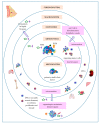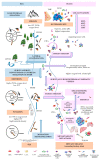Onco-Breastomics: An Eco-Evo-Devo Holistic Approach
- PMID: 38338903
- PMCID: PMC10855488
- DOI: 10.3390/ijms25031628
Onco-Breastomics: An Eco-Evo-Devo Holistic Approach
Abstract
Known as a diverse collection of neoplastic diseases, breast cancer (BC) can be hyperbolically characterized as a dynamic pseudo-organ, a living organism able to build a complex, open, hierarchically organized, self-sustainable, and self-renewable tumor system, a population, a species, a local community, a biocenosis, or an evolving dynamical ecosystem (i.e., immune or metabolic ecosystem) that emphasizes both developmental continuity and spatio-temporal change. Moreover, a cancer cell community, also known as an oncobiota, has been described as non-sexually reproducing species, as well as a migratory or invasive species that expresses intelligent behavior, or an endangered or parasite species that fights to survive, to optimize its features inside the host's ecosystem, or that is able to exploit or to disrupt its host circadian cycle for improving the own proliferation and spreading. BC tumorigenesis has also been compared with the early embryo and placenta development that may suggest new strategies for research and therapy. Furthermore, BC has also been characterized as an environmental disease or as an ecological disorder. Many mechanisms of cancer progression have been explained by principles of ecology, developmental biology, and evolutionary paradigms. Many authors have discussed ecological, developmental, and evolutionary strategies for more successful anti-cancer therapies, or for understanding the ecological, developmental, and evolutionary bases of BC exploitable vulnerabilities. Herein, we used the integrated framework of three well known ecological theories: the Bronfenbrenner's theory of human development, the Vannote's River Continuum Concept (RCC), and the Ecological Evolutionary Developmental Biology (Eco-Evo-Devo) theory, to explain and understand several eco-evo-devo-based principles that govern BC progression. Multi-omics fields, taken together as onco-breastomics, offer better opportunities to integrate, analyze, and interpret large amounts of complex heterogeneous data, such as various and big-omics data obtained by multiple investigative modalities, for understanding the eco-evo-devo-based principles that drive BC progression and treatment. These integrative eco-evo-devo theories can help clinicians better diagnose and treat BC, for example, by using non-invasive biomarkers in liquid-biopsies that have emerged from integrated omics-based data that accurately reflect the biomolecular landscape of the primary tumor in order to avoid mutilating preventive surgery, like bilateral mastectomy. From the perspective of preventive, personalized, and participatory medicine, these hypotheses may help patients to think about this disease as a process governed by natural rules, to understand the possible causes of the disease, and to gain control on their own health.
Keywords: breast cancer (BC); eco-evo-devo theories; onco-breastomics; progression; tumorigenesis.
Conflict of interest statement
The authors declare no conflicts of interest.
Figures


References
Publication types
MeSH terms
Grants and funding
LinkOut - more resources
Full Text Sources
Medical

